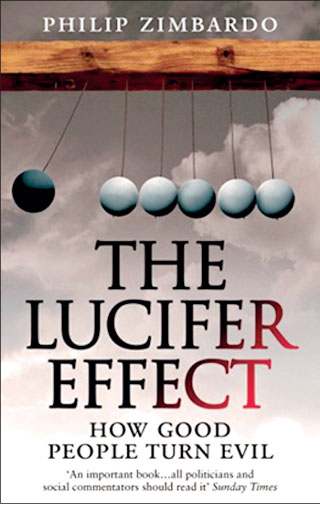Saturday Apr 19, 2025
Saturday Apr 19, 2025
Monday, 16 January 2023 00:01 - - {{hitsCtrl.values.hits}}
 With the political battles boiling up with possible elections being round the corner, we have ample evidence as to “how good people turn evil.” The word Lucifer is associated with a proud, rebellious main angel, identified with Satan, who has supposed to be fallen from heaven. What is attributed to Prof. Philip Zimbardo of Stanford fame, as the Lucifer Effect or Zimbardo Effect is much common in our societies. Let’s discuss the deeper details with reflections on leaders in action.
With the political battles boiling up with possible elections being round the corner, we have ample evidence as to “how good people turn evil.” The word Lucifer is associated with a proud, rebellious main angel, identified with Satan, who has supposed to be fallen from heaven. What is attributed to Prof. Philip Zimbardo of Stanford fame, as the Lucifer Effect or Zimbardo Effect is much common in our societies. Let’s discuss the deeper details with reflections on leaders in action.
Overview
Whilst politically powerful people in prisons receive publicity, prisons are supposed to remand and rehabilitate people. The Stanford Prison experiment was a study of the psychological effects of becoming a prisoner or prison guard. The experiment was conducted at Stanford University from August 14 to August 20 of 1971 by a team of researchers led by psychology professor Philip George Zimbardo. He observes the event as follows:
“My most notable study was the 1971 Stanford Prison Experiment, which was a classic demonstration of the power of social situations to distort personal identities and long cherished values and morality as students internalized situated identities in their roles as prisoners and guards.”
Experiment details
Twenty-four male students out of seventy-five were selected to take on randomly assigned roles of prisoners and guards in a mock prison situated in the basement of the Stanford psychology building. The participants adapted to their roles well beyond Zimbardo’s expectations, as the guards enforced authoritarian measures and ultimately subjected some of the prisoners to psychological torture.
Many of the prisoners passively accepted psychological abuse. At the request of the guards, they readily harassed other prisoners who attempted to prevent it. The experiment even affected Zimbardo himself. He in his role as the superintendent permitted the abuse to continue. Two of the prisoners quit the experiment early and the entire experiment was abruptly stopped after only six days. Certain portions of the experiment were filmed, and excerpts of footage are publicly available. Commenting on this, Zimbardo says:
“How we went about testing these questions and what we found may astound you. Our planned two-week investigation into the psychology of prison life had to be ended prematurely after only six days because of what the situation was doing to the college students who participated. In only a few days, our guards became sadistic, and our prisoners became depressed and showed signs of extreme stress. Please join me on a slide tour describing this experiment and uncovering what it tells us about the nature of human nature.”
 |
 |
| Prof. Philip Zimbardo
|
Aims involved
The main aim was to test the idea that the inherent personality traits of prisoners and guards are the chief cause of abusive behaviour in prison. Participants were recruited and told they would participate in a two-week prison simulation. Out of 70 respondents, Zimbardo and his team selected the 24 males whom they deemed to be the most psychologically stable and healthy. According to Stanford university sources, these participants were predominantly white and middle-class. The group was intentionally selected to exclude those with criminal background, psychological impairments, or medical problems. They all agreed to participate in a 7 to 14 day period and received a stipend of $ 15 per day.
The experiment was conducted in the basement of the (Stanford’s psychology building. Zimbardo took on the role of the superintendent and an undergraduate research assistant the role of the warden. Zimbardo designed the experiment in order to induce, what he calls three Ds, namely disorientation, de-personalisation, and de-individualisation in the participants.
Process adapted
The researchers held an orientation session for guards the day before the experiment, during which they instructed them not to physically harm the prisoners. It is in record how Zimbardo instructed the guards:
“You can create in the prisoner’s feelings of boredom, a sense of fear to some degree, you can create a notion of arbitrariness that their life is totally controlled by us, by the system, you, me, and they’ll have no privacy... We’re going to take away their individuality in various ways. In general, what all this leads to is a sense of powerlessness. That is, in this situation we’ll have all the power, and they’ll have none.”
The guards were given wooden batons and clothing similar to that of an actual prison guard such as khaki shirt and pants. They were also given mirrored sunglasses to prevent eye contact. Prisoners wore uncomfortable ill-fitting smocks and stocking caps, as well as a chain around one ankle. Guards were instructed to call prisoners by their assigned numbers, sewn on their uniforms, instead of by name.
The prisoners were arrested at their homes and charged with armed robbery. The local Police department assisted Zimbardo with the arrests and conducted full booking procedures on the prisoners, which included fingerprinting and taking mug shots. They were transported to the mock prison from the police station, where they were strip-searched and given their new identities.
The small mock prison cells were set up to hold three prisoners each. There was a small space for the prison yard, solitary confinement, and a bigger room across from the prisoners for the guards and warden. The prisoners were to stay in their cells all day and night until the end of the study. The guards worked in teams of three for eight-hour shifts. The guards did not have to stay on site after their shift.
Interim scene
After only 36 hours, one prisoner began to act “crazy”. As Zimbardo described:
“No. 8612 then began to act crazy, to scream, to curse, and to go into a rage that seemed out of control. It took quite a while before we became convinced that he was really suffering and that we had to release him.”
Guards forced the prisoners to repeat their assigned numbers in order to reinforce the idea that this was their new identity. Guards soon used these prisoner counts to harass the prisoners, using physical punishment such as protracted exercise for errors in the prisoner count. Sanitary conditions declined rapidly, exacerbated by the guards’ refusal to allow some prisoners to urinate or defecate anywhere but in a bucket placed in their cell. As punishment, the guards would not let the prisoners empty the sanitation bucket.
Mattresses were a valued item in the prison, so the guards would punish prisoners by removing their mattresses, leaving them to sleep on concrete. Some prisoners were forced to be naked as a method of degradation. Several guards became increasingly cruel as the experiment continued; experimenters reported that approximately one-third of the guards exhibited genuine sadistic tendencies. Most of the guards were upset when the experiment concluded after only 6 days.
Revealing results
What drives much of the fascination with the experiment is the sense that any individual could become a brutal dictator if given the chance. Zimbardo is still surprised at how quickly the participants changed their stripes. “These guys were all peaceful,” he recalled of the students chosen to be guards. “They became like Nazis.” “It shows how easy it is for good people to become perpetrators of evil.”
Zimbardo argued that the prisoners had internalised their roles, since even though some had stated that they would accept “parole” even if it would mean forfeiting their pay, they did not quit when their parole applications were all denied. Zimbardo was of the view that they had no reason for continued participation in the experiment after having lost all monetary compensation, yet they did, because they had internalised the prisoner identity.
The results of the experiment have been argued to demonstrate the impactful nature of human behaviour under obedience. This is especially when they are provided with social and institutional support. The experiment has also been used to illustrate the use or misuse of the power of authority.
Reflections on ravaging reality
In the much acclaimed book, “The Lucifer Effect,” Prof. Zimbardo offers a first-hand experience sharing of how good students become “evil” prison guards in excessively harassing the inmates (who were also students). As he observes:
“The Lucifer Effect raises a fundamental question about the nature of human nature: How is it possible for ordinary, average, even good people to become perpetrators of evil? In trying to understand unusual or aberrant behavior, we often err in focusing exclusively on the inner determinants of genes, personality, and character, as we also tend to ignore what may be the critical catalyst for behavior change in the external Situation or in the System that creates and maintains such situations. I challenge readers to reflect on how well they really know themselves, and how much confidence they have in what they would or would not ever do when put into new behavioral settings. “
The Stanford Prison experiment highlights several key lessons for us. Some situations can exert powerful influences over individuals, causing them to behave in ways they would not, could not, predict in advance. Situational power is most salient in novel settings in which the participants cannot call on previous guidelines for their new behaviour and have no historical references to rely on.
Situational power involves ambiguity of role boundaries, authoritative or institutionalised permission to behave in prescribed ways or to disinhibit traditionally disapproved ways of responding. With regard to role playing, even when acknowledged to be artificial and temporary – can still come to exert a profoundly realistic impact on the actors. Good people can be induced, seduced, initiated into behaving in evil (irrational, stupid, self- destructive, anti-social) ways by immersion in “total situations” that can transform human nature in ways that challenge our sense of the stability and consistency of individual personality, character, and morality.
Way forward
What Zimbardo showed us confirms what Five Hundred and Fifty Jathaka Stories told us a long time ago. The sad effects of abusing power and use of authority excessively have been highlighted in media in relation to both public and private institutions. Leaders at all fronts are exposed when they cross over from being good to being corrupt (a form of evil). It is a reflection for us to consider as individuals and institutions alike. The upcoming election if held could be an opportune time for the intelligent public to minimise the Lucifer Effect taking place in Sri Lankan soil.
(The writer is immediate past Director of the Postgraduate Institute of Management, and can be reached through [email protected], [email protected] or www.ajanthadharmasiri.info.)